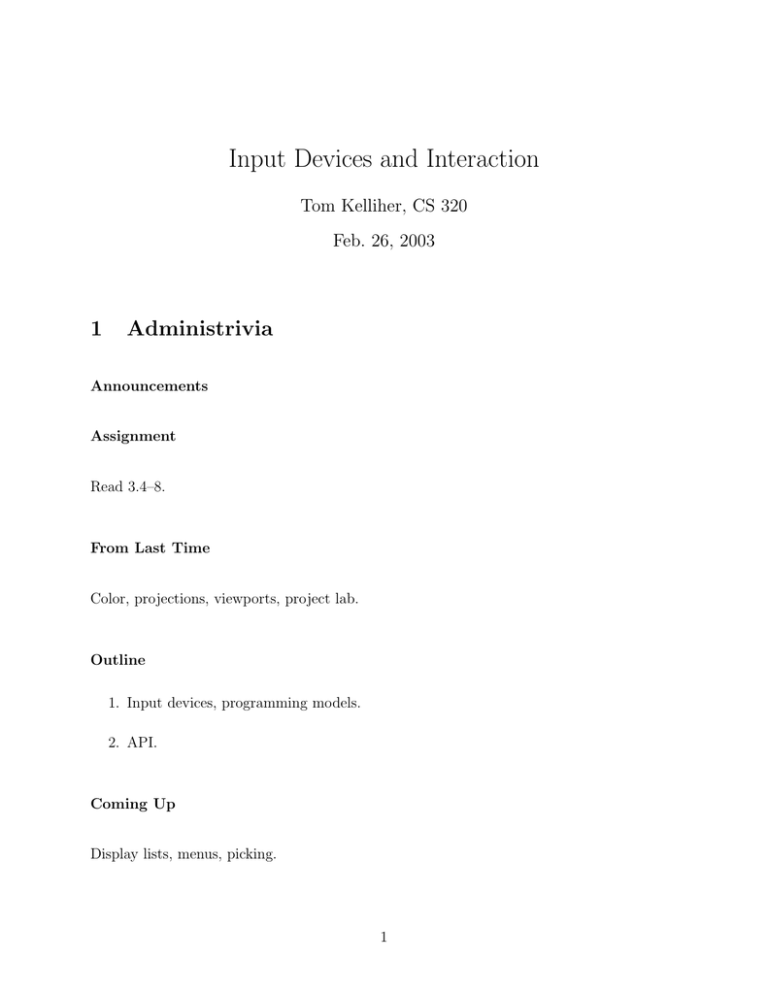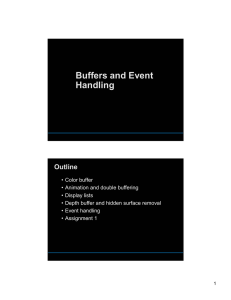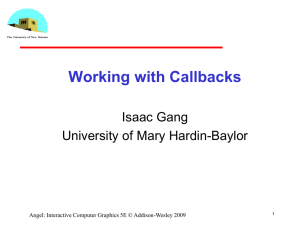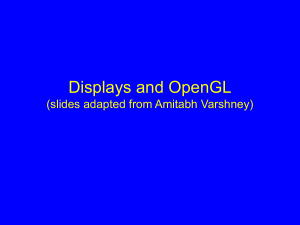Input Devices and Interaction 1 Administrivia Tom Kelliher, CS 320
advertisement

Input Devices and Interaction
Tom Kelliher, CS 320
Feb. 26, 2003
1
Administrivia
Announcements
Assignment
Read 3.4–8.
From Last Time
Color, projections, viewports, project lab.
Outline
1. Input devices, programming models.
2. API.
Coming Up
Display lists, menus, picking.
1
2
Input Devices
Physical devices: Keyboard, mouse, trackball, data tablet, light pen, touch screen, joy stick.
How do mice, light pens work?
Pointing device necessary to interact with graphics.
What about 3-D interaction? (Space ball, data gloves)
2.1
Logical Input Devices
1. String.
2. Locator: Returns (x, y). Convert window coordinates to world coordinates.
3. Pick: Select an object. Must determine what object was selected.
4. Choice: widget menus.
5. Dial: scroll bars. Again, widgets.
6. Stroke: mouse drag.
3
Input Device Program Interaction Models
Terminology:
1. Measure: The data — (x, y), input string, etc.
2. Trigger: User indication that the measure should be taken — “Enter” key, mouse click.
Interaction modes:
2
1. Request (synchronous wait) mode.
Measure not returned until trigger.
Advantages/disadvantages.
2. Sample (asynchronous poll) mode.
Measure returned any time.
Advantages/disadvantages.
3. Event mode.
Queue of (trigger, measure) pairs. Asynchronous.
Advantages/disadvantages.
OpenGL, callbacks, and glutMainLoop().
4
Input Device API
1. glutMouseFunc(pointerToMouseCallbackFunction)
2. void MouseCallbackFunction(int button, int action, int x, int y)
(a) GLUT_LEFT_BUTTON, etc.
(b) GLUT_UP, GLUT_DOWN.
(c) x and y are window -relative coordinates.
Example:
// ...
glutMouseFunc(mouse);
// ...
void mouse(int btn, int action, int x, int y)
3
{
if (btn == GLUT_LEFT_BUTTON && action == GLUT_DOWN)
{
myInit(rows, cols, 1);
visit(1, 1);
glutPostRedisplay();
}
else if (btn == GLUT_RIGHT_BUTTON && action == GLUT_UP)
exit(0);
}
3. glutMotionFunc(pointerToMotionFunction)
Also, glutPassiveMotionFunc().
4. void MotionFunction(int x, int y)
(a) Active motion — mouse button depressed.
(b) How do we know which mouse button is depressed?
(c) Again, window-relative coordinates.
5. glutKeyboardFunc(pointerToKeyboardFunction)
6. void KeyboardFunction(unsigned char key, int x, int y)
(a) key is ASCII of key depressed.
(b) Yet again, window-relative coordinates.
(c) See glutSpecialFunc() for non-ASCII keys.
Example:
#define ESC 0x1b
// ...
glutKeyboardFunc(keyboard);
4
// ...
void keyboard(unsigned char key, int x, int y)
{
switch (key)
{
case ’w’:
case ’W’:
printf("The Clinton people took all these keys.\n");
break;
case ESC:
exit(0);
break;
case ’!’:
globalThermonuclearWar();
// Not reached.
break;
// ...
others:
fatal("Un-recognized key.\n");
break;
}
}
7. glutDisplayFunc(pointerToDisplayFunction)
8. void DisplayFunction(void)
(a) Callback generated by window system events.
(b) Can self-generate with glutPostRedisplay().
9. glutReshapeFunc(pointerToReshapeFunction)
10. void ReshapeFunction(GLsizei w, GLsizei h)
As previously discussed, have to reconcile clipping region aspect ratio to window aspect
ratio.
5










